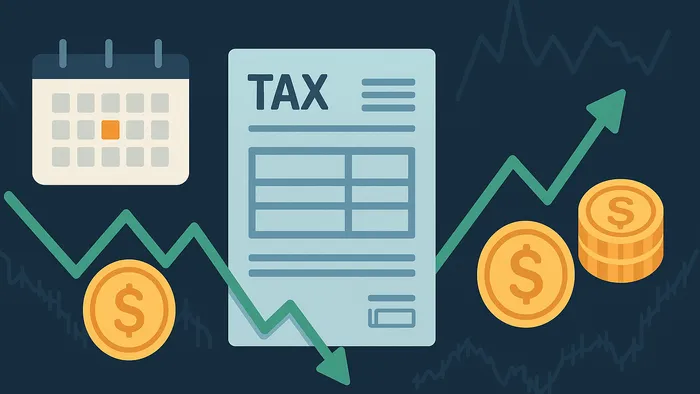Understanding the tax implications of short-term and long-term gains can significantly impact your investment strategy and overall tax burden.
If you're trading or investing, understanding how taxes work is crucial. The length of time you hold an asset – whether short-term (1 year or less) or long-term (more than 1 year) – can significantly impact how much tax you pay. Here's a quick breakdown:
- Short-term gains are taxed as ordinary income, with rates up to 37% depending on your income.
- Long-term gains enjoy lower rates: 0%, 15%, or 20%, based on your income level.
- Tax-saving tips: Use tax-loss harvesting, time your trades, and consider tax-advantaged accounts like IRAs or 401(k)s to reduce tax burdens.
Quick Comparison
| Category | Short-Term Gains | Long-Term Gains |
|---|---|---|
| Holding Period | 1 year or less | More than 1 year |
| Tax Rate | Ordinary income rates (10–37%) | Lower rates (0%, 15%, 20%) |
| Best for | Day traders, frequent traders | Investors holding for over a year |
To minimize taxes, plan your trades strategically, track your records, and explore deductions like losses to offset gains. Whether you're a day trader or a buy-and-hold investor, smart tax planning can make a big difference.
Capital Gains Tax: Short-Term vs Long-Term (Explained)
Short-Term Gains: 1-Year Trading Tax Rules
What Counts as Short-Term Gains
Short-term capital gains happen when you sell an asset you've held for one year or less. For example, if you buy Tesla shares on March 1, 2025, and sell them before March 1, 2026, you'll trigger short-term gains. The holding period starts the day after you purchase the asset.
Current Short-Term Tax Rates
Short-term capital gains are taxed as ordinary income, meaning they're subject to the same tax brackets as your regular earnings. For 2025, these rates range from 10% to 37%. Here's a breakdown of the federal income tax brackets for 2025:
| Filing Status | 10% Bracket | 12% Bracket | 22% Bracket | 24% Bracket | 32% Bracket | 35% Bracket | 37% Bracket |
|---|---|---|---|---|---|---|---|
| Single | Up to $11,925 | $11,926 – $48,475 | $48,476 – $103,350 | $103,351 – $197,300 | $197,301 – $250,525 | $250,526 – $626,350 | Over $626,350 |
| Head of Household | Up to $17,000 | $17,001 – $64,850 | $64,851 – $103,350 | $103,351 – $197,300 | $197,301 – $250,500 | $250,501 – $626,350 | Over $626,350 |
| Married Filing Jointly | Up to $23,850 | $23,851 – $96,950 | $96,951 – $206,700 | $206,701 – $394,600 | $394,601 – $501,050 | $501,051 – $751,600 | Over $751,600 |
| Married Filing Separately | Up to $11,925 | $11,926 – $48,475 | $48,476 – $103,350 | $103,351 – $197,300 | $197,301 – $250,525 | $250,526 – $375,800 | Over $375,800 |
"Some exceptions exist to the maximum capital gains tax rate of 20%. For instance, gains from the sale of collectibles and qualified small business stock are taxed at 28%, and gains from the sale of certain real property where prior depreciation was claimed are taxed at 25%." – Kelly Wallace, CPA, Homedale, Idaho
If you're a high-income trader, you may also face a 3.8% Net Investment Income Tax (NIIT) on modified adjusted gross income (AGI) over $200,000 for single filers or $250,000 for joint filers. For frequent traders, understanding these rates is essential.
Effects on Day Trading
Day traders, who rely solely on short-term trades, are especially impacted by these higher tax brackets. Taxes can take a significant bite out of profits, so factoring them into every trade is key. Traders who meet IRS criteria and elect Section 475 "mark-to-market" accounting can deduct all trading losses and related expenses.
To reduce your tax burden, consider these strategies:
- Use tax-advantaged accounts like IRAs for frequent trading
- Employ tax-loss harvesting to offset gains
- Keep detailed records of all trades
- Schedule larger trades during years with lower income
These methods pair well with other tax strategies discussed later in this guide, helping you manage the tax impact of active trading more effectively.
Long-Term Gains: Tax Benefits After 1 Year
What Counts as Long-Term Gains
Long-term capital gains apply when you sell an investment you've held for over 12 months. For example, if you purchase shares on March 1, 2025, you must keep them until at least March 2, 2026, to qualify for these benefits.
Take this example: Melanie Grant bought shares in TechNet Limited for $175,000. After holding them for several years, she sold them for $220,000, earning a $45,000 long-term capital gain. Now that we’ve clarified the qualification rules, let’s dive into how these gains are taxed at lower rates.
Lower Tax Rates Explained
Long-term capital gains are taxed at lower rates compared to short-term gains. For 2024, here’s how the rates break down based on your income:
| Filing Status | 0% Rate | 15% Rate | 20% Rate |
|---|---|---|---|
| Single | Up to $47,025 | $47,026 – $518,900 | Over $518,900 |
| Married Filing Jointly | Up to $94,050 | $94,051 – $583,750 | Over $583,750 |
| Head of Household | Up to $63,000 | $63,001 – $551,350 | Over $551,350 |
| Married Filing Separately | Up to $47,025 | $47,026 – $291,850 | Over $291,850 |
"The IRS gives you a tax break for holding investments for at least a year by reducing the taxes on the profits you make from their sale."
If your modified AGI exceeds $200,000 (single) or $250,000 (married filing jointly), an additional 3.8% Net Investment Income Tax might apply.
Advantages for Position Traders
Long-term investors enjoy lower tax rates compared to day traders, who face higher short-term rates. For high-income traders, the difference can be as much as 17%.
To make the most of these benefits, consider these strategies:
- Strategic Timing: Sell during lower-income years to stay within favorable tax brackets.
- Gradual Selling: Spread large gains across multiple years to avoid moving into higher tax brackets.
- Charitable Giving: Donate appreciated stocks held for over a year to qualified charities. This avoids capital gains taxes and allows you to deduct the stock's fair market value.
"Even a 20% tax may be a small price to pay for success. You can celebrate keeping the 80%. Still, there are several strategies you might consider discussing with your tax professional to help reduce what you may owe in capital gains taxes," says Joe Curtin, head of CIO Portfolio Management at Merrill and Bank of America Private Bank.
For traders managing large portfolios, combining these approaches with thoughtful tax planning can result in better after-tax returns compared to frequent trading methods.
Tax Reduction Methods for Traders
Tax-Loss Harvesting Steps
Tax-loss harvesting is a way to offset capital gains, particularly short-term gains, which are taxed at higher rates. Christopher Fuse, an asset allocation portfolio manager at Fidelity, notes, "It helps clients get to their goals faster."
Here’s how to approach it:
- Spot Underperforming Assets: Identify investments that are losing value and may be good candidates for harvesting.
- Plan Sales Carefully: Start early in the year to maximize opportunities. Amit Poddar from U.S. Bank Private Wealth Management advises, "In an ideal scenario, you want to take your losses and offset your short-term capital gains, since they're taxed at a higher rate."
- Steer Clear of Wash Sales: Follow the IRS rule by waiting 30 days before repurchasing the same or similar securities.
These steps can be integrated into your overall tax planning for better results.
Tax-Sheltered Account Options
In addition to tax-loss harvesting, using tax-advantaged accounts can help reduce your tax burden. For 2025, here are the contribution limits:
| Account Type | Annual Contribution Limit | Catch-up Contribution (50+) | Total Possible |
|---|---|---|---|
| IRA | $7,000 | $1,000 | $8,000 |
| 401(k) | $23,500 | $7,000 | $30,500 |
To optimize your tax strategy:
- Place actively traded investments, which generate short-term gains, in tax-advantaged accounts.
- Hold long-term investments in taxable accounts to take advantage of lower capital gains rates.
Trade Timing for Tax Savings
Proper timing of trades can significantly impact your tax savings. Thomas Paradise, CFA, from Vanguard's Enterprise Advice group, explains:
"Investing requires exposure to volatility for effective tax-loss harvesting. Without it, investors can't use losses to offset taxes. However, realizing these losses only benefits those with enough gains or a high tax rate."
Here are some timing strategies to consider:
- Use excess capital losses to offset up to $3,000 of ordinary income annually.
- Carry forward any unused losses to future tax years indefinitely.
- Schedule larger trades around year-end to manage when gains or losses are realized.
Tax Reporting Requirements
Trade Record Requirements
Keeping detailed and accurate records is essential for traders to meet their tax responsibilities. The IRS requires traders to document all trading activities thoroughly.
Here’s what you need to keep for 2025:
| Document Type | Retention Period | Key Details |
|---|---|---|
| Trade Blotters | 6 years | Dates, prices, quantities of trades |
| Trade Confirmations | 3 years | Transaction details, fees, commissions |
Failing to maintain proper records could lead to penalties and fines. Staying organized ensures smoother tax filing.
How to File Trading Taxes
When filing trading taxes, classify your gains based on how long you held the assets:
- Short-Term Gains (1 year or less): Taxed as ordinary income, with rates reaching up to 37% for top earners. Report these on Schedule D of Form 1040.
- Long-Term Gains (more than 1 year): Eligible for lower tax rates of 0%, 15%, or 20%, depending on your income level.
After filing, make sure to double-check your forms and avoid common mistakes.
Common Tax Filing Mistakes
Even with proper documentation, there are common errors to watch out for:
- Documentation Issues: Cross-check account statements and confirmations to ensure dates, prices, and security types are accurate.
- Cost Basis Errors: The default method is FIFO (first-in, first-out), unless you specify an alternative.
- Record Retention: The IRS allows any system that clearly shows income, expenses, transaction details, and supporting documents for all trades.
"The IRS holds you responsible" for accurate records, so make sure your trades align with the details on Form 1099-B.
Conclusion: Smart Tax Planning for Traders
Short vs. Long-Term Tax Comparison
Tax rates vary depending on how long you hold an asset. Here's a quick breakdown:
| Tax Rate Type | Rate Range | Income Example (Single Filer) |
|---|---|---|
| Long-Term (>1 year) | 0 – 20% | 0% for income up to $48,350; 15% for $48,351 – $533,400; 20% above $533,400 |
| Short-Term (≤1 year) | 10 – 37% | Taxed as ordinary income |
| Additional NIIT | 3.8% | Applies to higher-income earners |
This comparison highlights the importance of planning your trades to align with favorable tax rates.
Tax Planning Basics
Effective tax planning can help reduce your overall tax burden. Using accounts like IRAs or 401(k)s can defer or even eliminate taxes on gains. Additionally, the IRS allows you to deduct up to $3,000 in realized losses from ordinary income, with any extra losses carried forward to future years.
These strategies form the foundation for smarter tax decisions.
Getting Started with Tax Management
To make the most of your tax strategy, consider these steps:
- Track everything: Keep detailed records of trades and expenses.
- Explore business structures: Setting up an LLC or electing Section 475 could provide tax advantages.
- Time your trades: Plan when to realize gains or losses to optimize your tax outcome.
Combine these tactics with methods like tax-loss harvesting and using tax-advantaged accounts. By aligning your documentation and trade timing with these strategies, you can reduce your tax liability while staying compliant.








